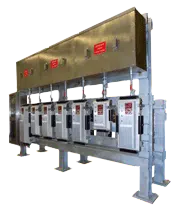
In hazardous environments where the presence of flammable gases, vapors, or combustible dust poses a significant risk, explosion-proof disconnects play a crucial role in ensuring the safety of electrical systems. While there may be a common misconception that these disconnects are designed to protect the components from external explosions, their primarypurpose is to contain internal arcing or sparking events. In this technical blog, we will explore the concept of hazardous location explosion-proof disconnects, how they effectively contain internal explosions, and the rigorous testing processes required to pass UL and hazardous location explosion tests.
I. Understanding Hazardous Location Explosion-Proof Disconnects:
Hazardous location explosion-proof disconnects are specialized electrical switch assemblies designed to mitigate the risks associated with internal arcing or sparking events. They are constructed to contain and prevent sparks, arcs, or heat generated within the enclosure from igniting the surrounding flammable atmosphere. By confining and extinguishing any potential explosions, these disconnects significantly reduce the risk of secondary explosions, which could be far more catastrophic.
1. Containing Internal Explosions:
The primary function of a hazardous location explosion-proof disconnect is to contain the internal explosion resulting from an arcing or sparking electrical device within the enclosure. Rather than protecting the components from external explosions, the disconnect is engineered to withstand and prevent the propagation of an explosion originating from within the enclosure. This critical feature prevents the ignition of the surrounding hazardous atmosphere, ensuring the safety of personnel and the preservation of property.
2. Construction and Design:
Hazardous location explosion-proof disconnects are meticulously designed to meet stringent safety standards and certifications. These disconnects employ several key design elements to contain and control internal explosions:
a. Robust Enclosure: The enclosure itself is constructed using materials with high mechanical strength and excellent resistance to heat and pressure. Copper-free aluminum and electro-galvanized steel are commonly used to ensure durability and integrity.
b. Reinforced Joints: The joints, seams, and connections of the enclosure are strengthened to withstand internal explosion forces and prevent leakage of ignited gases or particles.
c. Pressure Relief Mechanisms: To further enhance safety, explosion-proof disconnects are equipped with pressure relief mechanisms. These mechanisms allow controlled release of pressure in the event of an internal explosion, preventing excessive build-up and subsequent rupture of the enclosure.
d. Sealing and Gasketing: Special seals and gaskets are integrated into the design to maintain the integrity of the enclosure, preventing the escape of sparks, arcs, or gases into the hazardous environment.
3. Controlling Ignition Sources:
Hazardous location explosion-proof disconnects are designed with several features to control potential ignition sources within the enclosure:
a. Intrinsically Safe Design: The internal electrical components and connections are carefully engineered to minimize the risk of generating sparks or arcs during normal operation.
b. Robust Switching Mechanism: The switch mechanism within the disconnect is constructed using materials and designs that ensure reliable and efficient operation while minimizing the generation of sparks or arcs.
II. Testing and Certifications:
Hazardous location explosion-proof disconnects undergo rigorous testing procedures to obtain certifications and approvals, including UL (Underwriters Laboratories) and hazardous location explosion tests. These tests validate the ability of the disconnects to contain internal explosions and meet industry standards for safety.
1. UL Certification:
The UL certification is a widely recognized standard that ensures the safety and reliability of electrical equipment. Hazardous location explosion-proof disconnects undergo comprehensive testing as per UL standards to obtain this certification.
2. Hazardous Location Explosion Testing:
a. Test Chambers: Hazardous location explosion tests are conducted in specialized chambers that simulates the presence of flammable gases, vapors, or combustible dust.
b. Test Conditions: The disconnects are subjected to extreme conditions, including the introduction of an explosive atmosphere and the initiation of internal arcing or sparking events.
c. Containment Evaluation: During the tests, the ability of the enclosure to contain the explosion and prevent the escape of ignited gases or particles is closely evaluated. This is assessed through visual observations, pressure measurements, and the absence of external flames.
d. Performance Criteria: The disconnects must meet specific performance criteria defined by the testing standards, including pressure containment, absence of external ignition, and absence of sustained burning or secondary explosions.
III. Analogy: The Fire-Resistant Safe:
An analogy that helps to understand the purpose of hazardous location explosion-proof disconnect is a fire-resistant safe. Much like a fire-resistant safe is designed to protect valuable documents or objects from a fire that occurs outside the safe, explosion-proof disconnects are engineered to contain and control internal explosions. The primary objective is to prevent the ignition of the surrounding hazardous atmosphere and mitigate the potential damage caused by secondary explosions.
Conclusion:
Hazardous location explosion-proof disconnects are critical components for ensuring the safety of electrical systems in hazardous environments. By effectively containing and controlling internal arcing or sparking events, these disconnects play a pivotal role in preventing explosions and minimizing the associated risks. Moreover, through robust construction, reinforced joints, pressure relief mechanisms, and sealing features, these disconnects are designed to withstand and suppress internal explosions. Rigorous testing and certifications, such as UL and hazardous location explosion tests, validate their ability to meet industry standards and provide a reliable solution for hazardous environments. Lastly, understanding the true purpose of these disconnects dispels common misconceptions and highlights their vital role in safeguarding personnel and property in hazardous locations.
Written by: Cole Attaway
Cole Attaway is the founder and CEO of Spike Electric Controls. Spike's mission is to improve the accessibility and delivery of industrial electrical gear for clients nationwide. Spike solutions result in reduced unplanned downtime, less overtime, and greater operational efficiencies.


